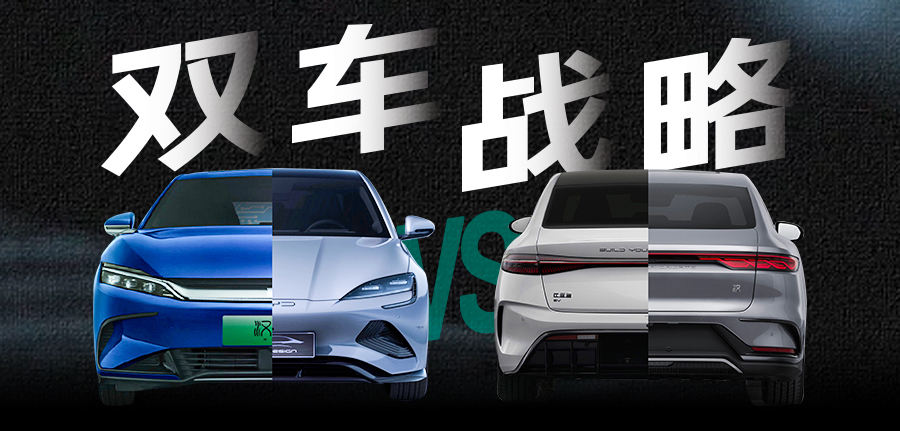BYD Dolphin may become the first “real” sports car in BYD’s brand. The Dolphin is equipped with e 3.0 platform and CTB technology, which seems unremarkable for BYD. What is remarkable is that the Dolphin is BYD’s first rear-wheel drive, the first car equipped with double-wishbone suspension, and the first car with front asynchronous and rear permanent magnet motor. Yes, its keyboard value is very high.
So, have you seen BYD that can break 100 km/h within 3.8 seconds and drift?
What’s more interesting is that the Dolphin has a presale price after subsidies of 212,800 yuan to 289,800 yuan, while the 2022 BYD Han EV Genesis edition has a post-subsidy price of 269,800 yuan to 288,600 yuan, plus the 214,800 yuan 2021 Han EV standard endurance luxury model. The price range and endurance capability of the two products overlap to a high degree.
Secondly, the wheelbase of the Dolphin is exactly the same as that of the Han EV, both are 2,920 mm. Therefore, on the day of the release conference, there were continuous calls in the comments section of “BYD is hitting itself”.
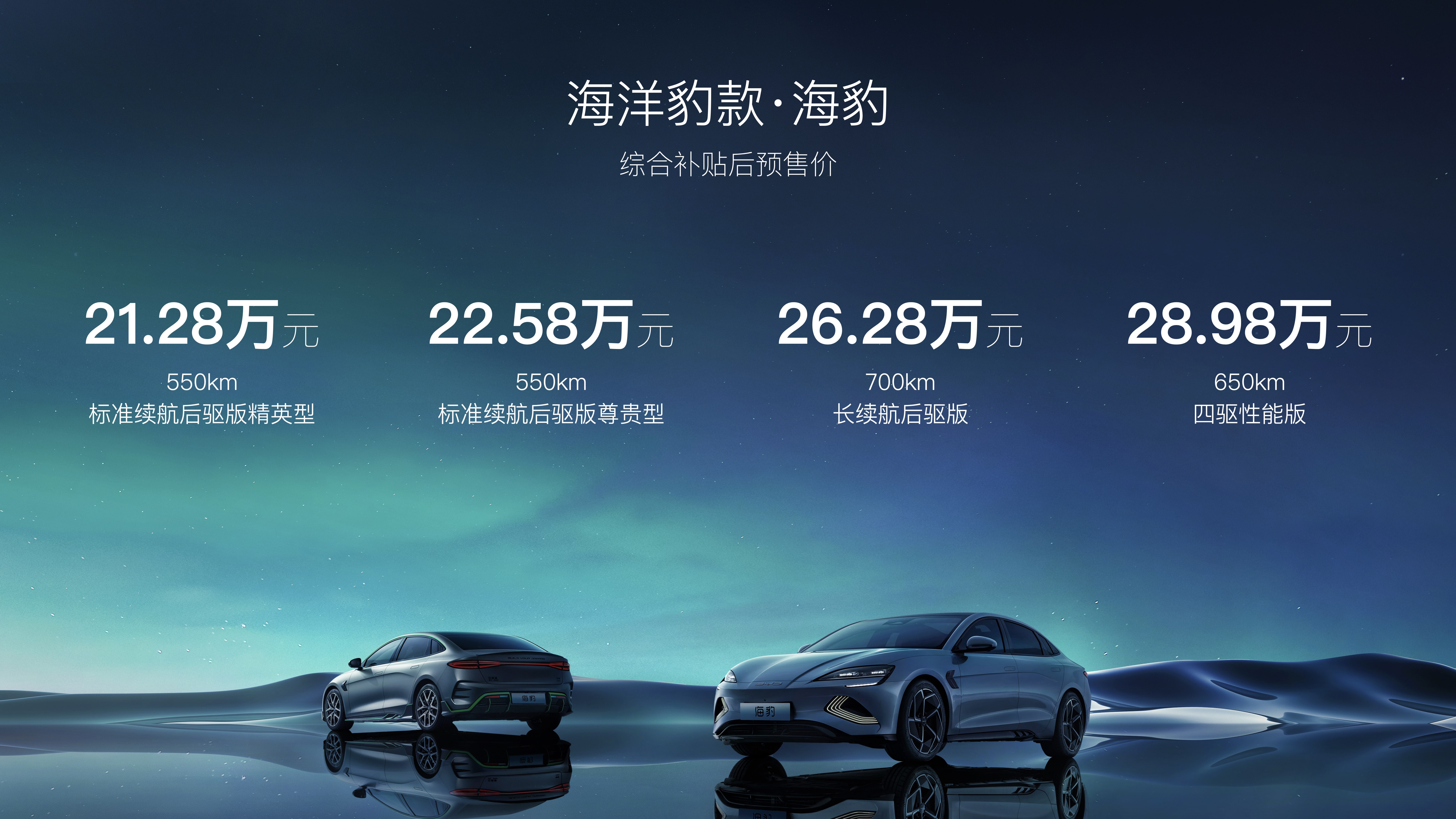
Today, we list the detailed configurations of BYD Dolphin and Han EV together to see how to choose between these two cars.
Marine appearance vs Dynasty appearance
The appearance of the car has always been a crucial part of people’s car-buying decisions. A good-looking appearance, whether for men or women, will become a key factor in quickening your wallet.
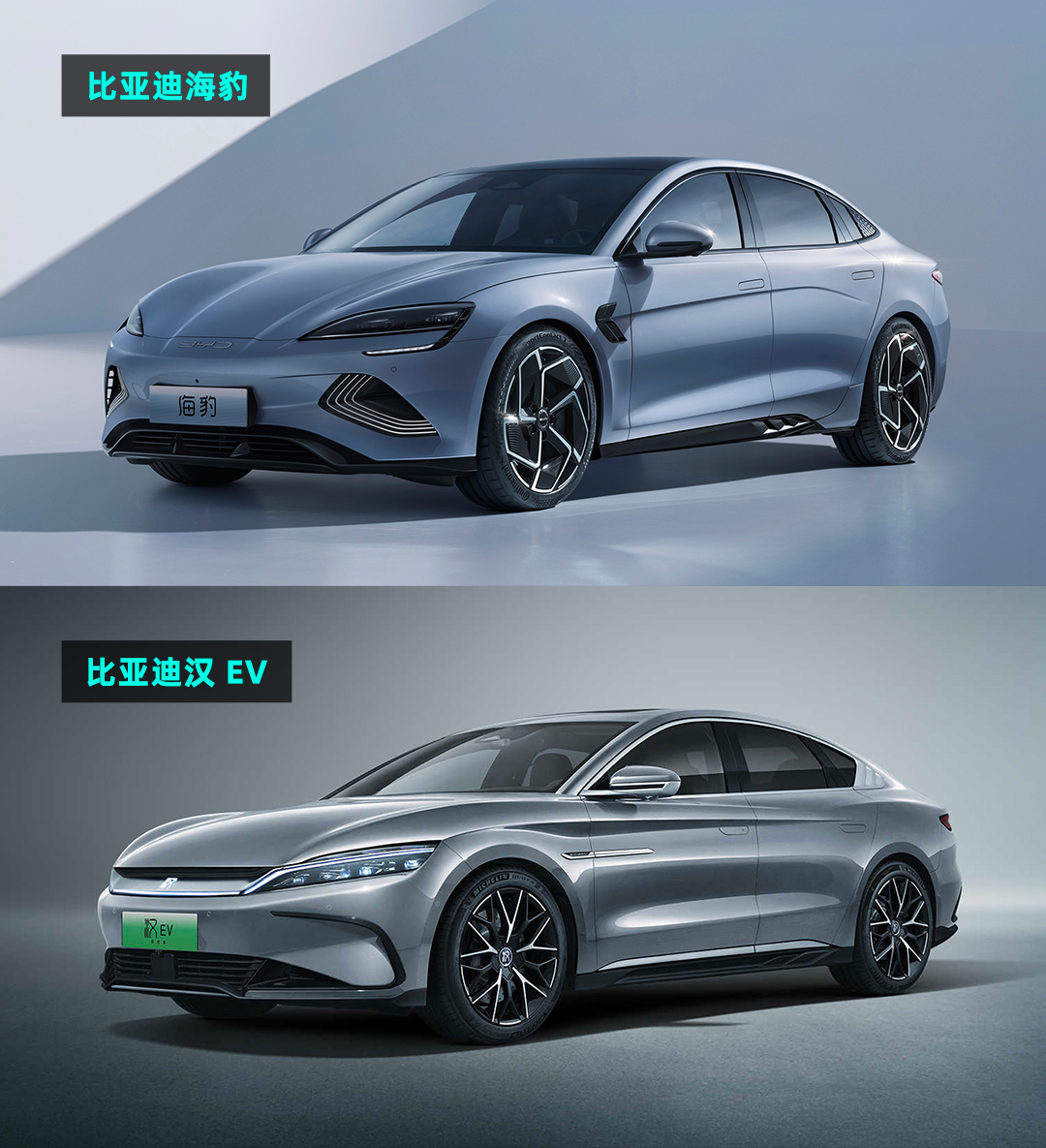
Comparing the appearance of BYD Dolphin and the 2022 Han EV, it is not difficult to find that the Dolphin no longer uses the family-style front face of the Dynasty series. After switching to the Marine Pure Electric platform, the Dolphin may create a new family-style design.
The two powerful lines on the front of the Dolphin extend all the way to the front bumper, similar to the front nose and wing of F1.
The headlights use a boomerang-shaped design commonly seen on sports cars, with LED light strips running from the headlight assembly to the front bumper. Other models that use boomerang-shaped designs include McLaren and Porsche Taycan, which is currently one of the designs that can increase recognition and add a sense of sportsmanship.
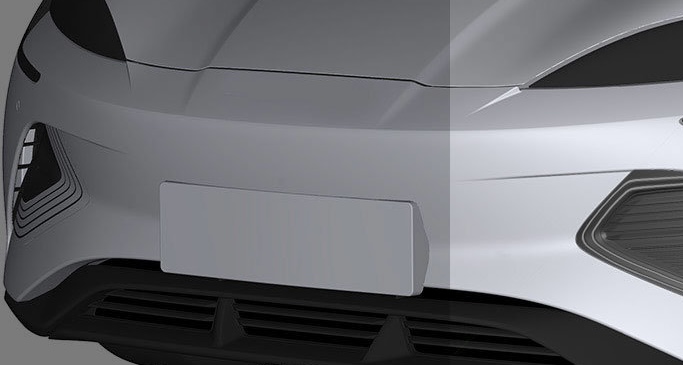
Under the seal, two air intakes with large area integrate the function of light strip. According to the previously exposed patent drawings, this air inlet has the practical function of active air intake, which can cool the caliper during driving against wind. As a medium-sized car that also focuses on sports, NIO ET5 has a similar design.

The appearance of BYD Han EV continues the family’s “Dragon Face” front face, which is also the main design element of the current BYD dynasty series. It is similar to the front face of the EV version models of Yuan, Song, and Tang.
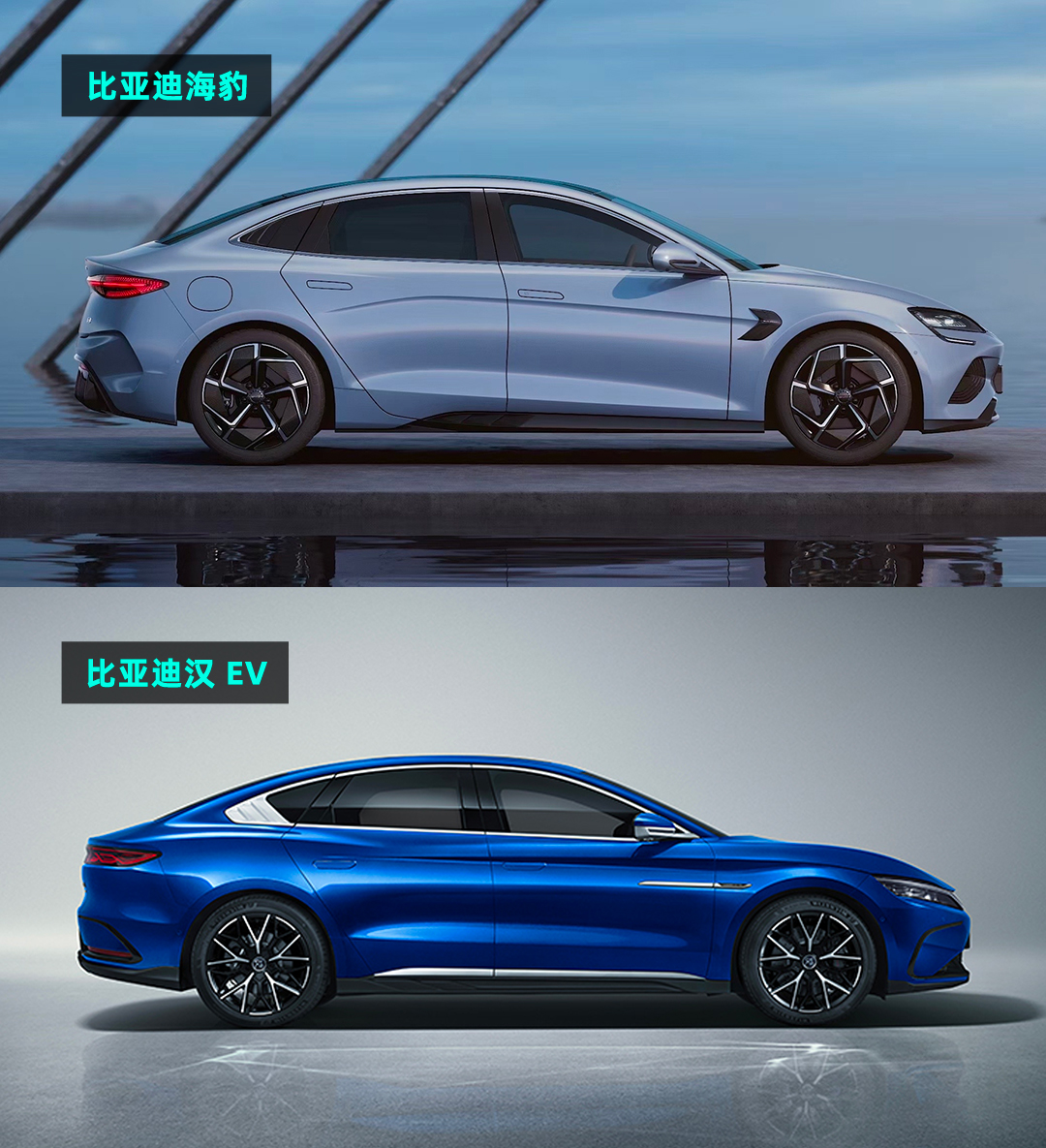
In terms of the side view of the car, because the seal has a rear-wheel drive structure and has a design with a short front suspension compared to Han EV, the body looks more compact. In addition, the sleek design of the seal also gives it a feeling of forward diving.
After the 22-model facelift, the rear design of BYD Han EV, which was criticized by everyone, has been improved. The new design has a more gentle line, especially the design behind the C-pillar is more integrated.
When the two cars are compared side by side, the more dynamic sea lion with more waistlines, while the flatter waistline gives Han EV a more slender overall visual impression. Of course, part of the reason why Han EV is more slender also comes from the car’s body size itself.
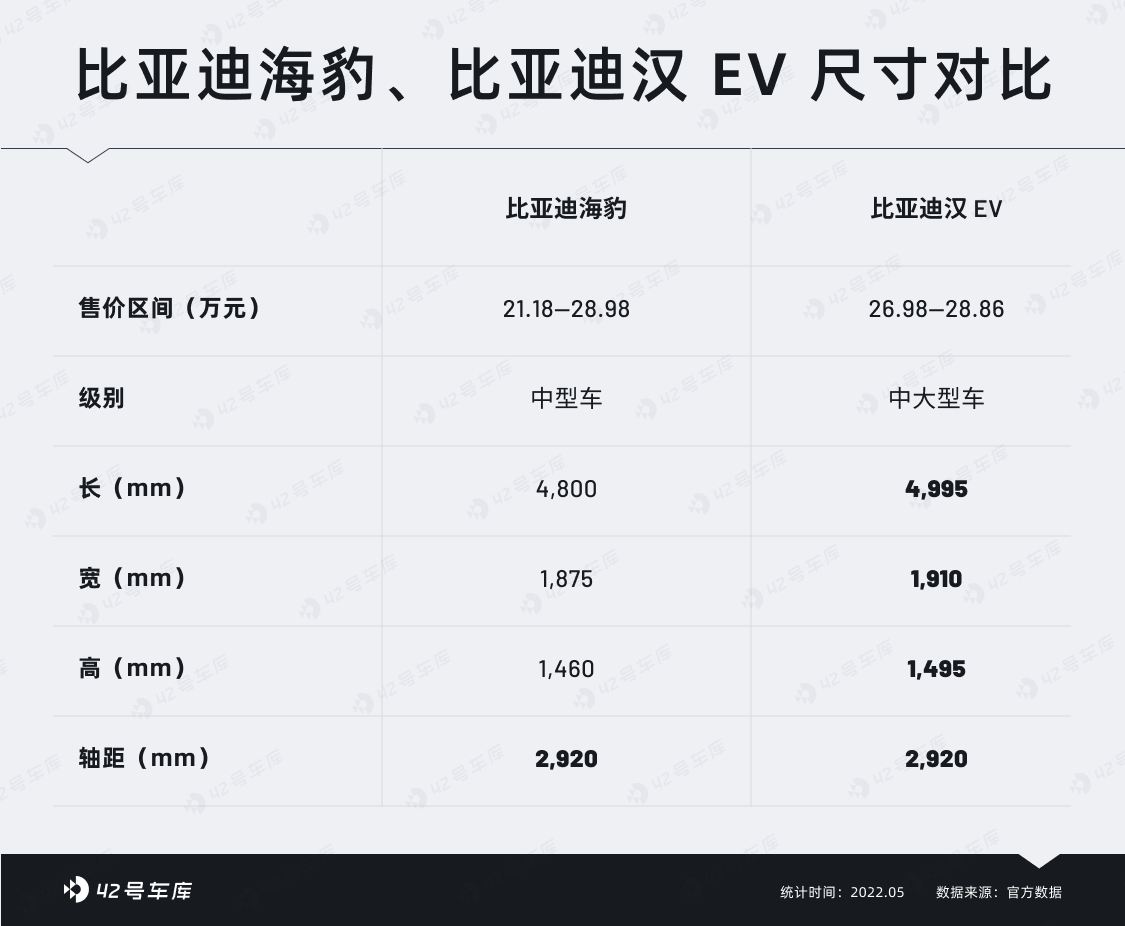
With the same wheelbase length, BYD Han EV has obvious advantages in length, width, and height, with a nearly 5-meter car length and a width of over 1.9 meters, making Han EV a mid-to-large-sized car.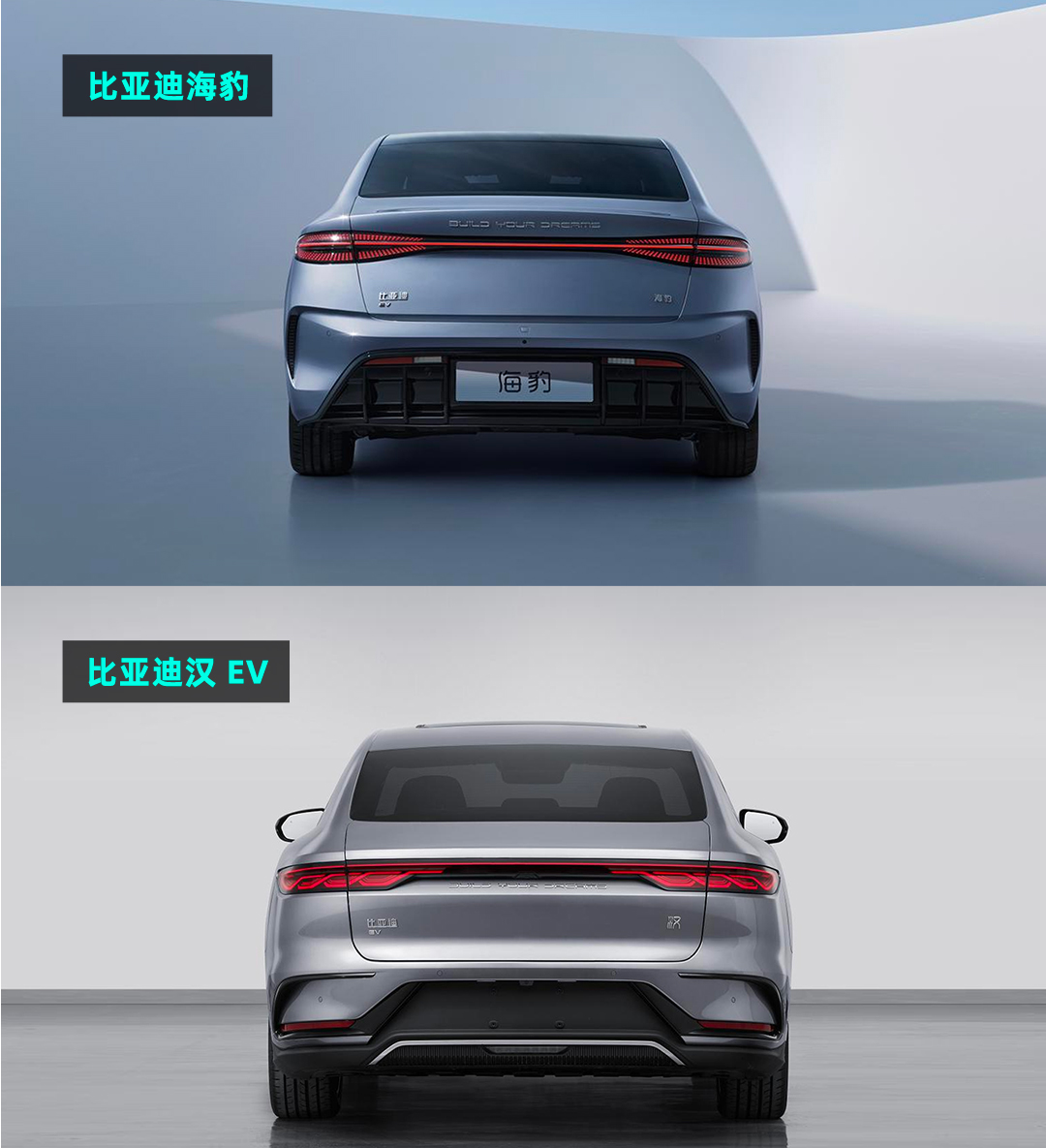
At the rear, both cars adopt a through-style taillight design. The seal’s taillight group features a dot-matrix LED particle design, while the redesigned version of Han’s taillights has a more layered and elegant appearance. At night, both cars have good recognition.
The tail design styles of both cars still echo the overall design. You can tell that the seal still has a sporty style from the large diffuser and the flow guide groove on both sides and under the rear bumper. Regardless of whether the flow grooves and diffusers are decorative, they can at least make the car’s positioning clear at a glance.
By contrast, the design of the Han EV is more restrained. The taillights use a through-style Chinese knot LED taillight, with a more streamlined appearance that is not as awkward as the old model. The horizontal stripe decoration plate on both sides of the license plate on the rear bumper of the old model is removed, and a more integrated trapezoidal black guard is installed, which is more advanced.
Overall, BYD is bringing the designs of these two cars closer to a younger audience. As a mid-size car, the seal has a more sporty appearance and seems to be more popular with young people. As a medium-to-large car, the Han EV still retains many of BYD’s classic elements, making this appearance more inclusive for a wider audience.
Interior design is the first step in differentiation
Elegant and classical, respectively
Entering the car, the differences in interior design between the seal and the Han EV are not significant. Since the seal is part of the marine series, it continues the design idea of marine aesthetics. The three-piece design of the steering wheel and the air outlet design on both sides of the air conditioning, which use biomimetics, look like a seal’s tail, which corresponds to the car’s name.

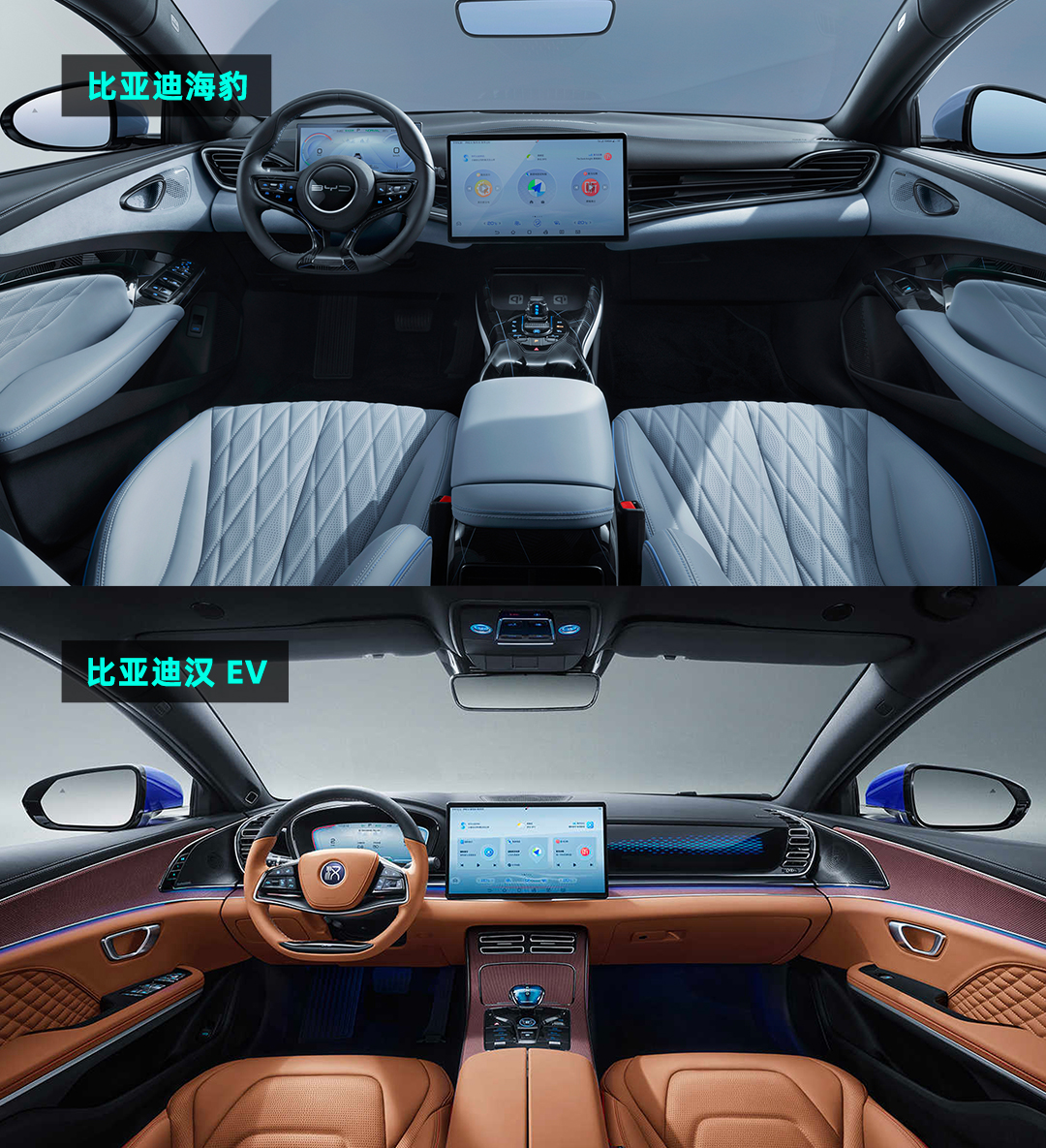
The interior of BYD Han is more business-like. The dual-color steering wheel with two spokes, the enclosing center console, and the air outlet with silver decorations make Han’s interior more classy. By comparison, the interior style of the seal is more elegant and also more loved by young people.
This is like young people preferring minimalist IKEA furniture over wood grain furniture from furniture cities, even if the prices are similar, young people will still choose IKEA furniture despite elder’s advice.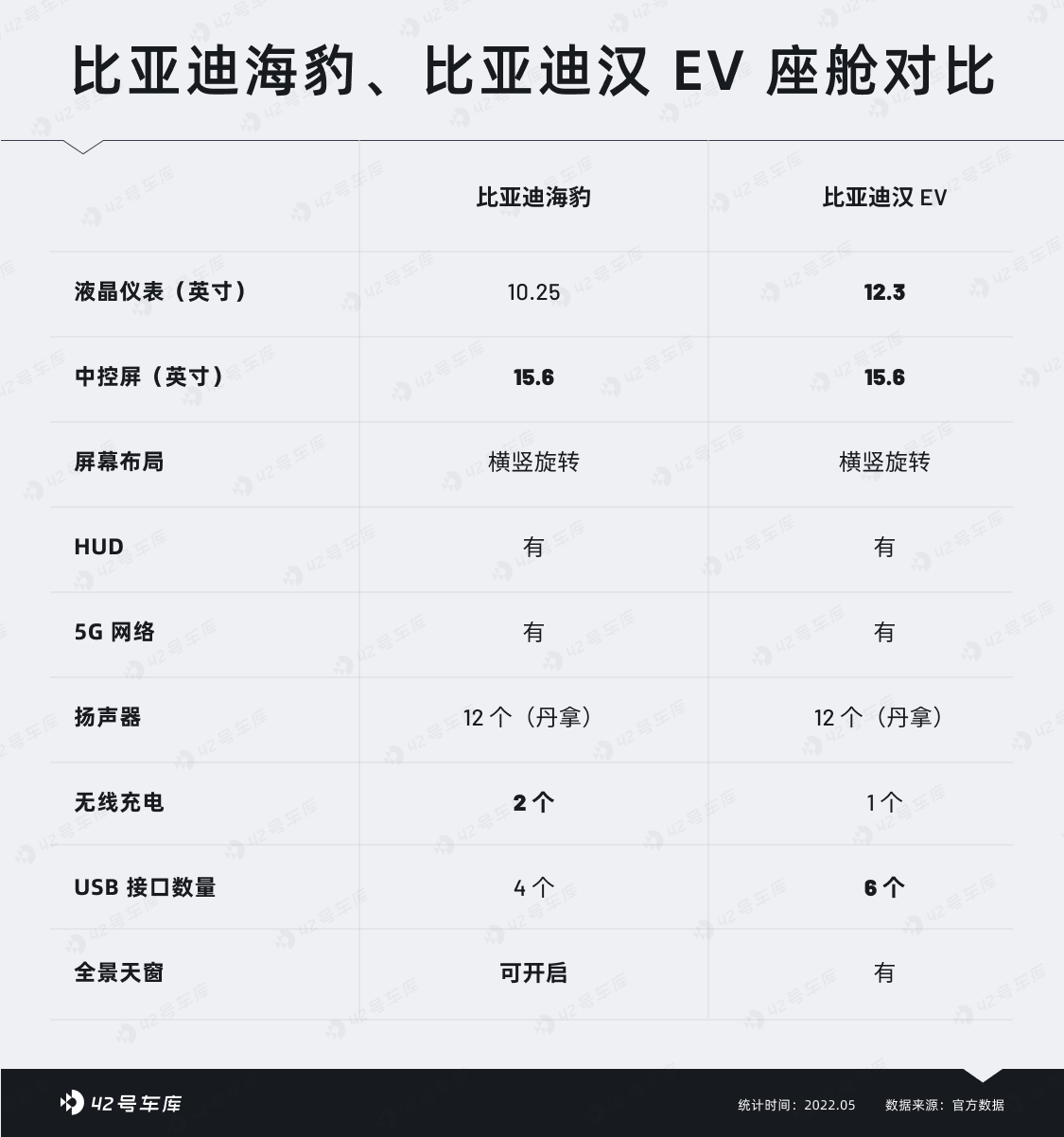
In terms of cabin configuration, the difference between the Byton and Han EV is not significant. The central control screens of both cars are large 15.6-inch screens that can be rotated horizontally and vertically, and both support 5G networks. Based on the comparison picture in the article, both cars belong to a unified system, with slight improvements in the theme interface. We can look forward to whether Byton will bring us surprises in actual experience.
Both the Byton and Han EV provide a 12-speaker Denon sound system in the cabin. Except for the base model, the Byton is equipped with this Denon sound system and a karaoke microphone as standard across the range. This means that when you travel with family and friends, listening to music and singing can add a lot of fun to the boring journey and charging process.
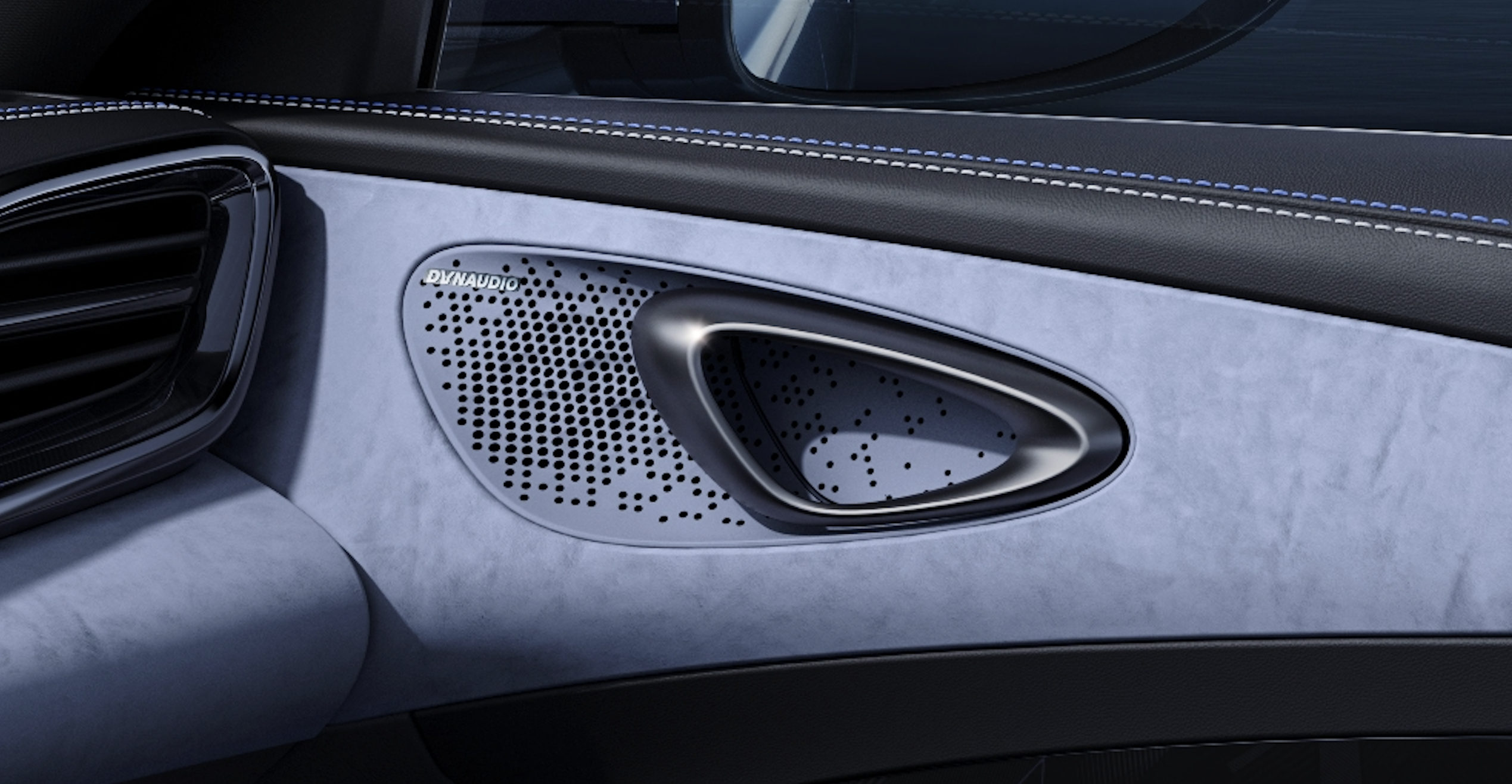
However, the basic model’s standard range rear-wheel drive model is not too bad, with 10 speakers, which will not cause any problems in your daily use. As for Denon’s specific performance, we will provide you with a detailed analysis after we get the car.
It is worth mentioning that Byton provides two phone wireless charging pads in the front row, so there is no need to fight for one charging position when both people in the car want to charge wirelessly. In addition, there are two USB ports in the front and rear rows respectively, which take good care of users’ mobile phone charging issues.
Although the Han EV only has one phone wireless charging pad, there are a staggering 6 USB ports throughout the car, which is a lot considering that there are only 5 seats in the car. When everyone in the car is charging their own phone, there are still 2 charging ports available.
The Rear Seats of the Han EV is the Turning Point
If the difference between the front seats of these two cars is not that significant, the difference in the rear seats can be said to be a turning point.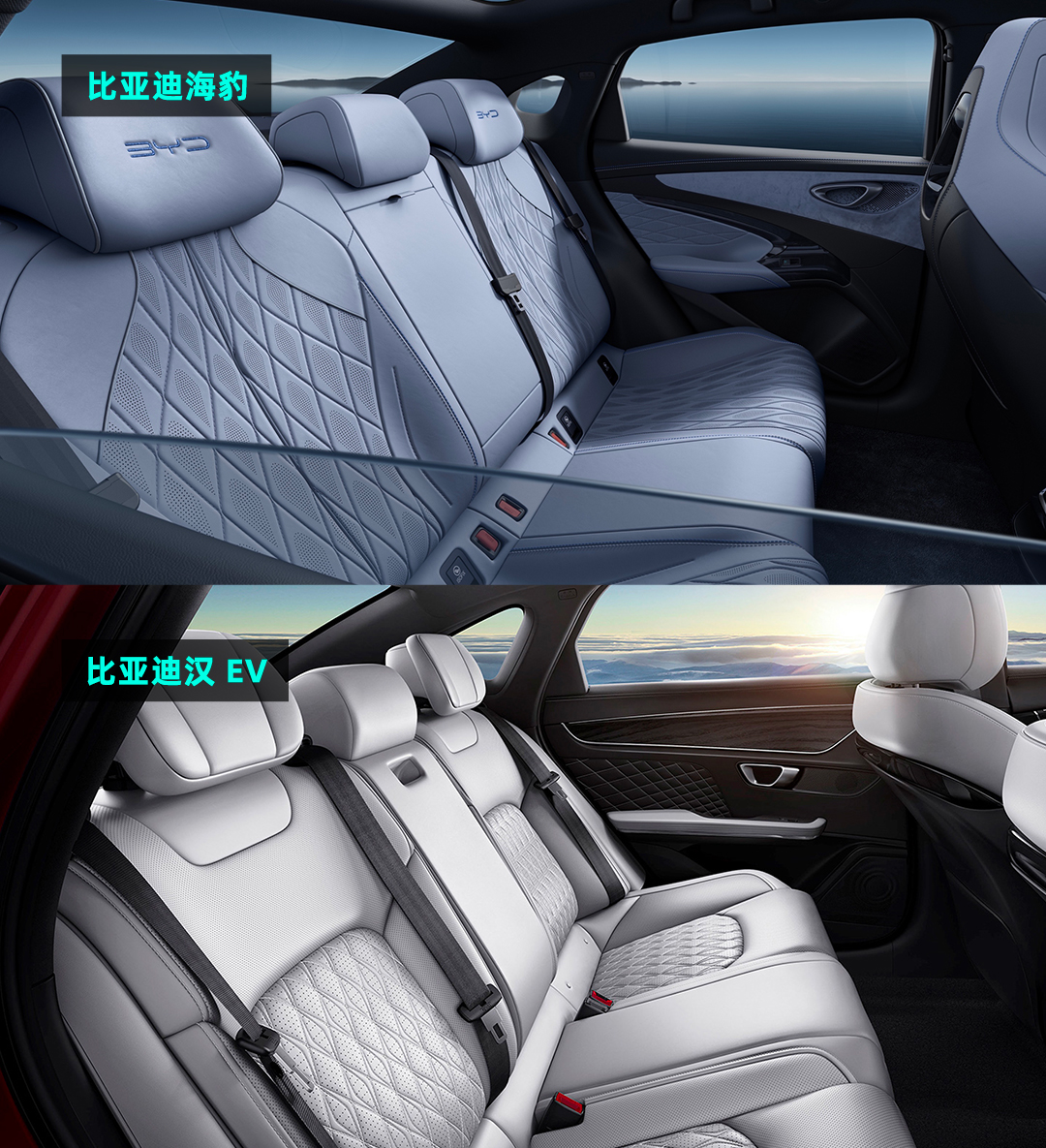
The wheelbase of both vehicles is 2,920 mm, and there is no need to worry about legroom in the rear seat for daily use. However, as shown in the side view above, the Haipao L113 with rear-wheel drive layout is longer and has a better posture, but the actual space is sacrificed. In addition, the headroom and ride comfort have always been the pain points of most current pure electric sedans, as the battery occupies space in the car.
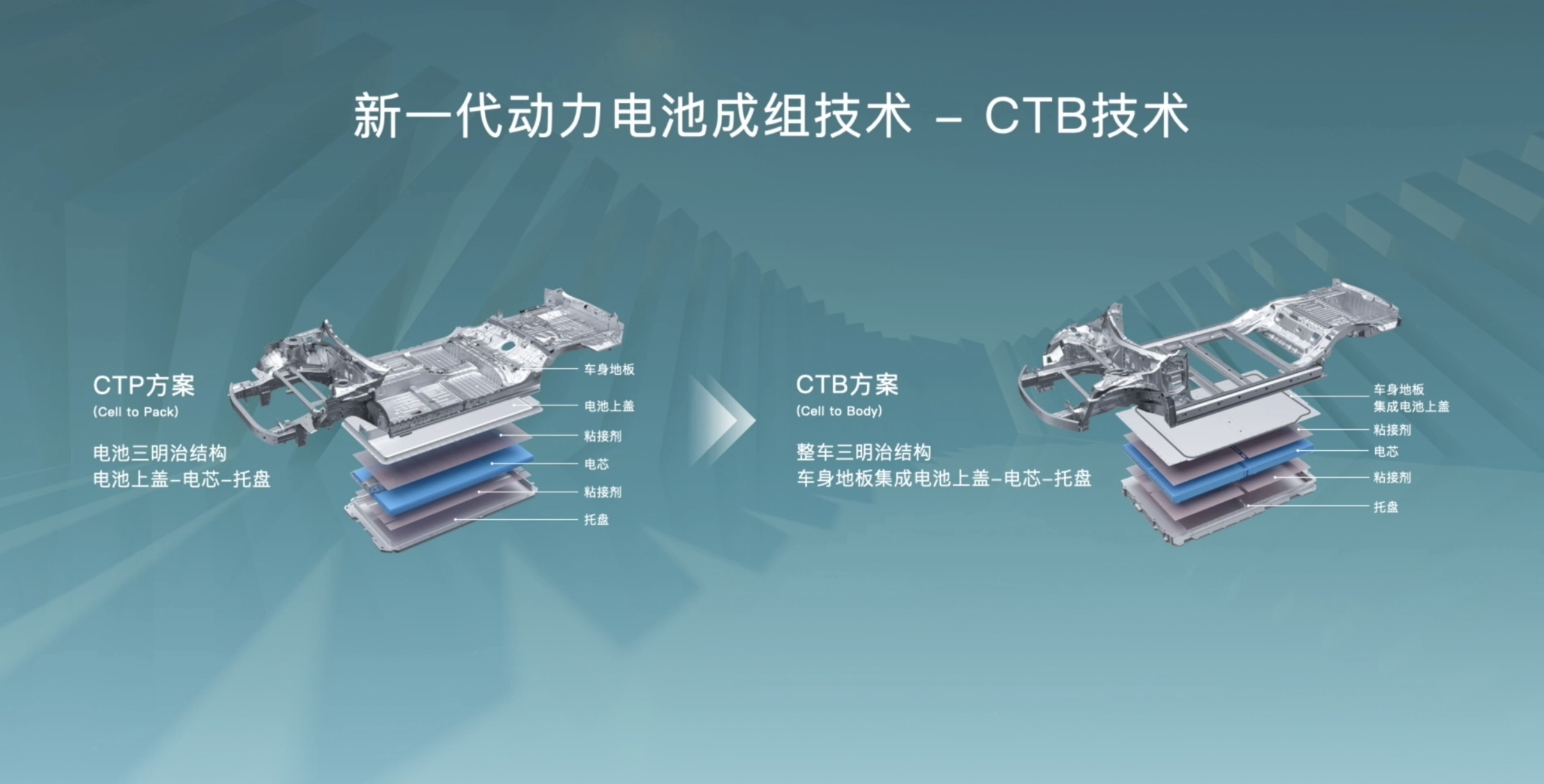
To improve the comfort with very thick cushions, it is inevitable to occupy headroom. To save space, Haipao’s CTB technology integrates the car body floor with the battery cover, and coupled with the relatively thin blade battery, it is said to release 10 mm of vertical space. In addition, the Haipao’s glass roof steals some space in the rear seat, and the performance of headroom and comfort is still worth looking forward to. In contrast, the Han EV without CTB and glass roof sacrifices 35 mm of headroom for more space.
The panoramic sunroof makes the vehicle more spacious and has better headroom, but it is inevitable to roast your head in the summer. Therefore, BYD provides an option of photosensitive sunroof on the top equipped model, which costs RMB 8,600. To solve this problem, buying a sunshade on Taobao is also a good option for those who are not short of money.
However, there is no need to worry about this issue in the BYD Han EV, which is equipped with an openable panoramic roof. Although its area is not as large as the panoramic sunroof, it is still practical as it is equipped with an electric sunshade.
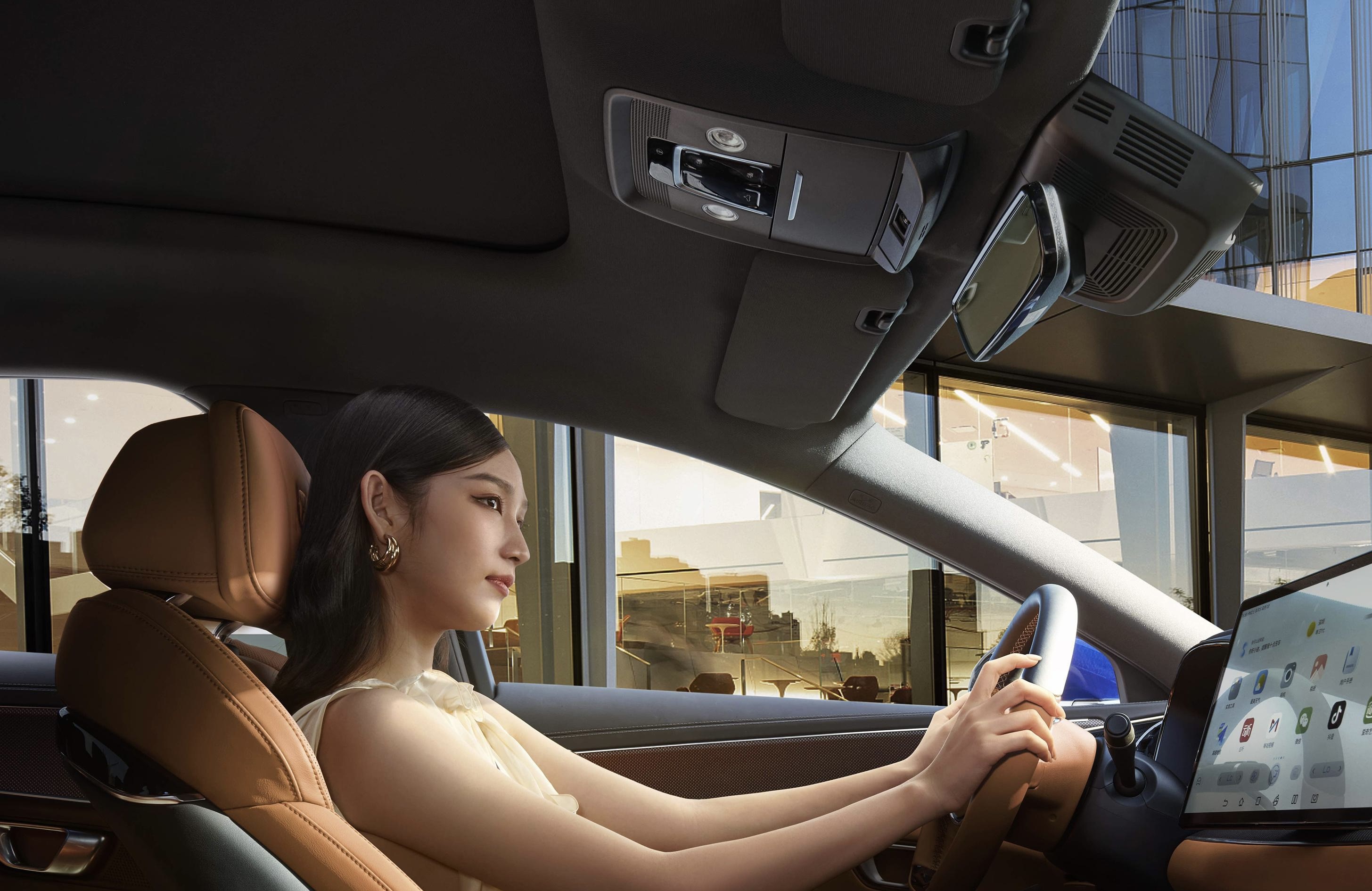
In addition, the two cars have the biggest difference in comfort configuration. As shown in the figure, the rear configuration of the BYD Han EV is quite rich. The single-zone air conditioner under the rear air outlet has independent control of air volume and temperature. The top equipped model also supports the option of rear central control system, rear seat heating and ventilation, and rear electric seat. It can be said that the rear seat passengers are well taken care of like bosses.
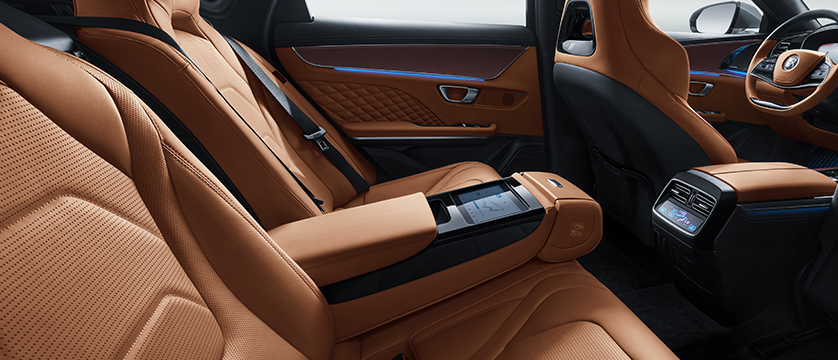 In addition to the rear seats, let me elaborate on the differences in the front seats. The Han EV series comes standard with a passenger key and the driver’s seat is equipped with 12-way electric adjustment and the passenger’s seat has 10-way electric adjustment. Compared with the comfort configuration of the Sea Lion, the difference is immediately apparent.
In addition to the rear seats, let me elaborate on the differences in the front seats. The Han EV series comes standard with a passenger key and the driver’s seat is equipped with 12-way electric adjustment and the passenger’s seat has 10-way electric adjustment. Compared with the comfort configuration of the Sea Lion, the difference is immediately apparent.
For the Sea Lion, all models except for the base model are equipped with heated and ventilated front seats for cities with distinct four seasons. On the Long Range and AWD versions, the front seats provide extra 4-way lumbar support adjustment and seat memory, which further enhances practicality.
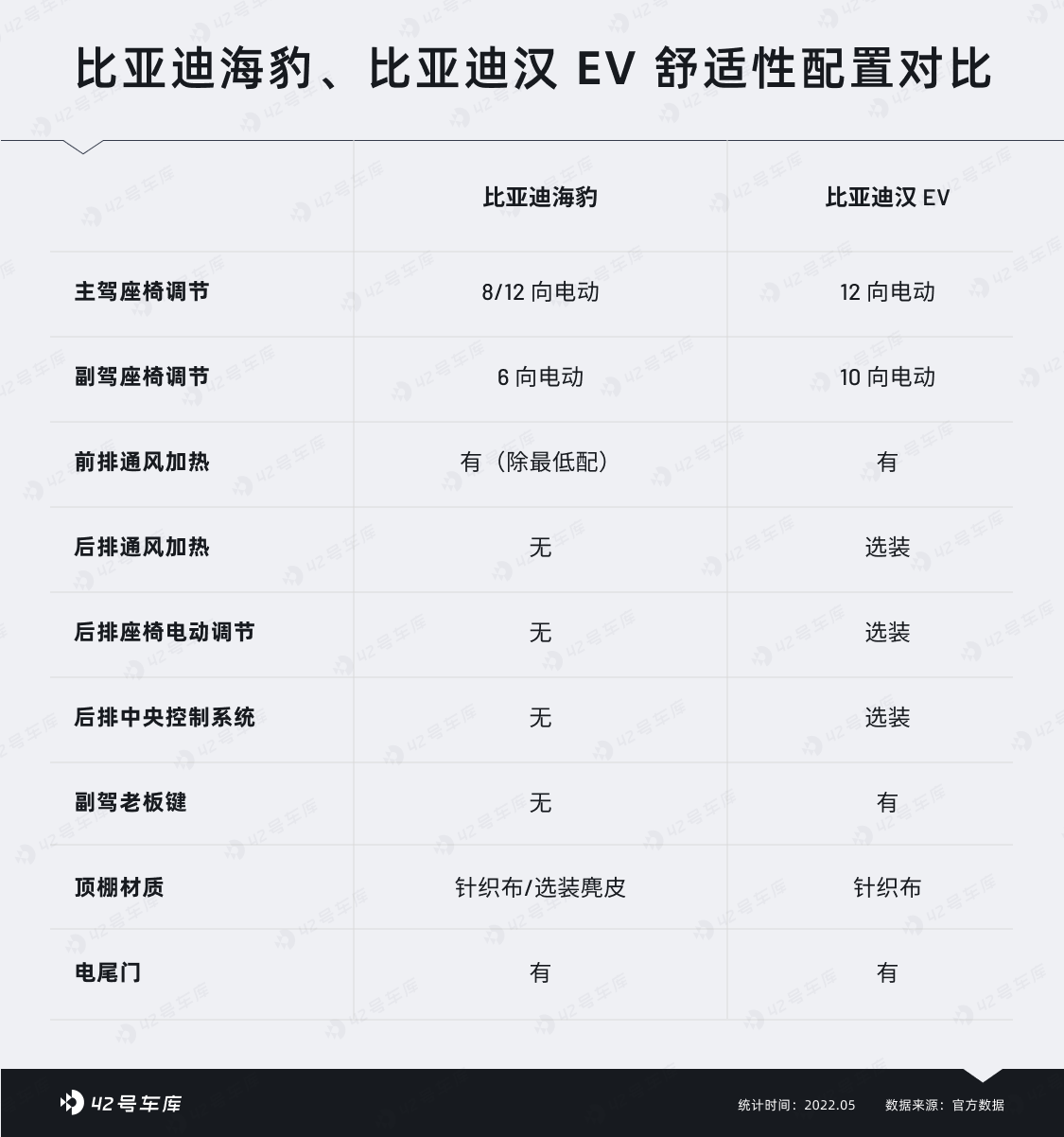
An interesting point is that the Sea Lion offers a suede roof as an optional addition, but this configuration is included in a package deal that also includes exterior kits. The option is not cheap, costing RMB 20,000. Personally, I don’t think it stands out particularly.
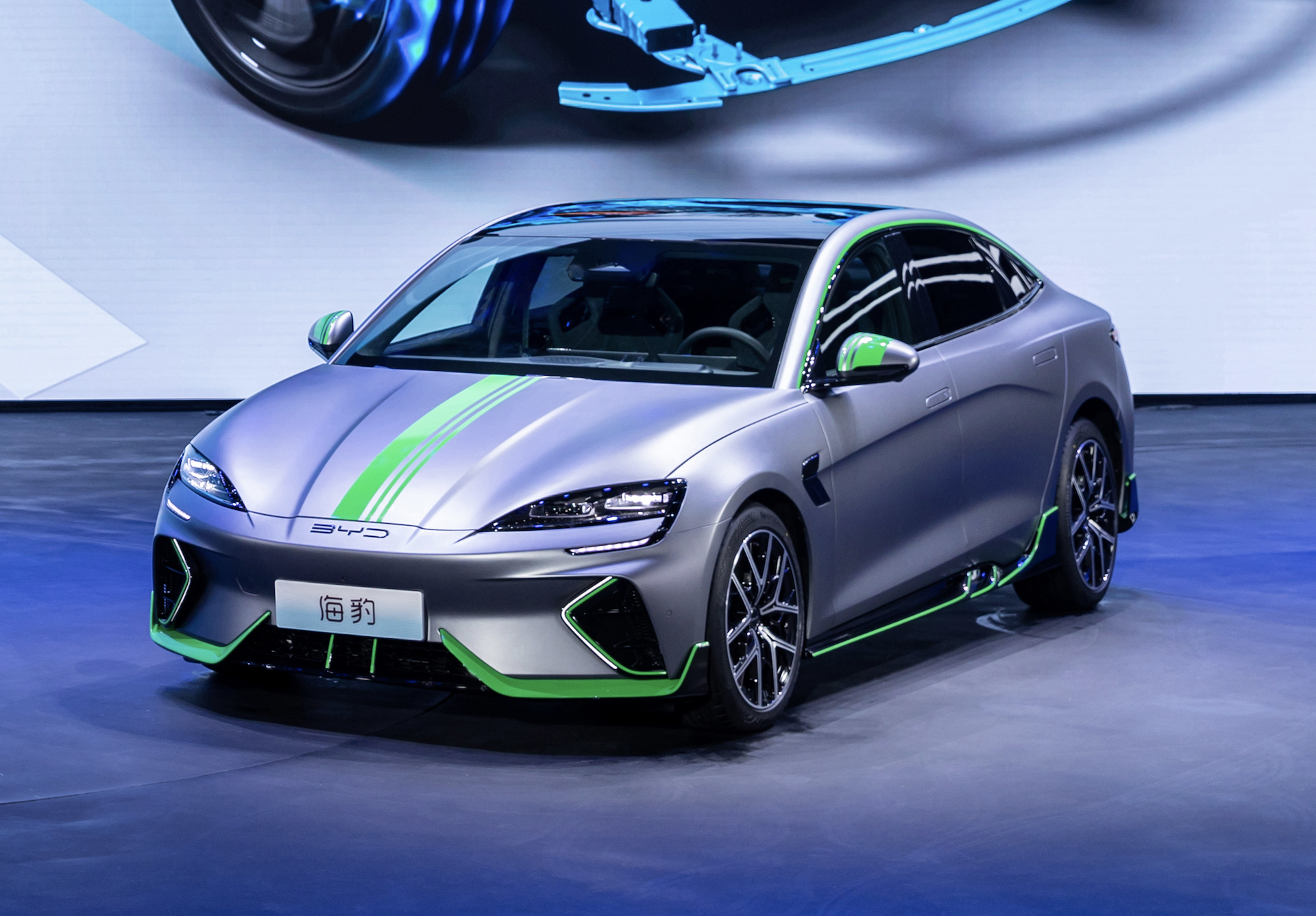
From an interior design perspective, it is evident that there are differences in the target audience between the BYD Sea Lion and Han EV. If users are looking for a more youthful design and have the same wheelbase, they can consider the BYD Sea Lion. If there is a need for comfort in the rear seats and if the users also need to consider corporate reception, the Han EV would be an excellent choice.
Further differentiation of power
Hardware technology, Sea Lion is sports-oriented
The interior design has already distinguished the differences in positioning between the Sea Lion and Han EV, and the driving attributes can further distinguish the differences between the two.
The BYD Sea Lion is the first passenger car to use a rear-wheel-drive + front double-wishbone architecture, and the four-wheel-drive model also uses BYD’s first combination of front asynchronous and rear permanent magnet motors. For these few configuration points, the Sea Lion has a very high score on sportiness, so this is also the first time I have seen a BYD sedan drift. However, rear-wheel drive does not necessarily mean driving pleasure, as some automakers can tune rear-wheel drive cars to have a very understeering orientation. Thus, further experience is needed to evaluate it.
It’s worth noting that the Sea Lion offers the option of the iTAC intelligent torque control system on the four-wheel drive performance version. This so-called iTAC is more like an ESP body stability system on an electric vehicle. Its main function is to compensate for the low accuracy of ESP’s body attitude detection and the limited corrective approach, which is too rigid.
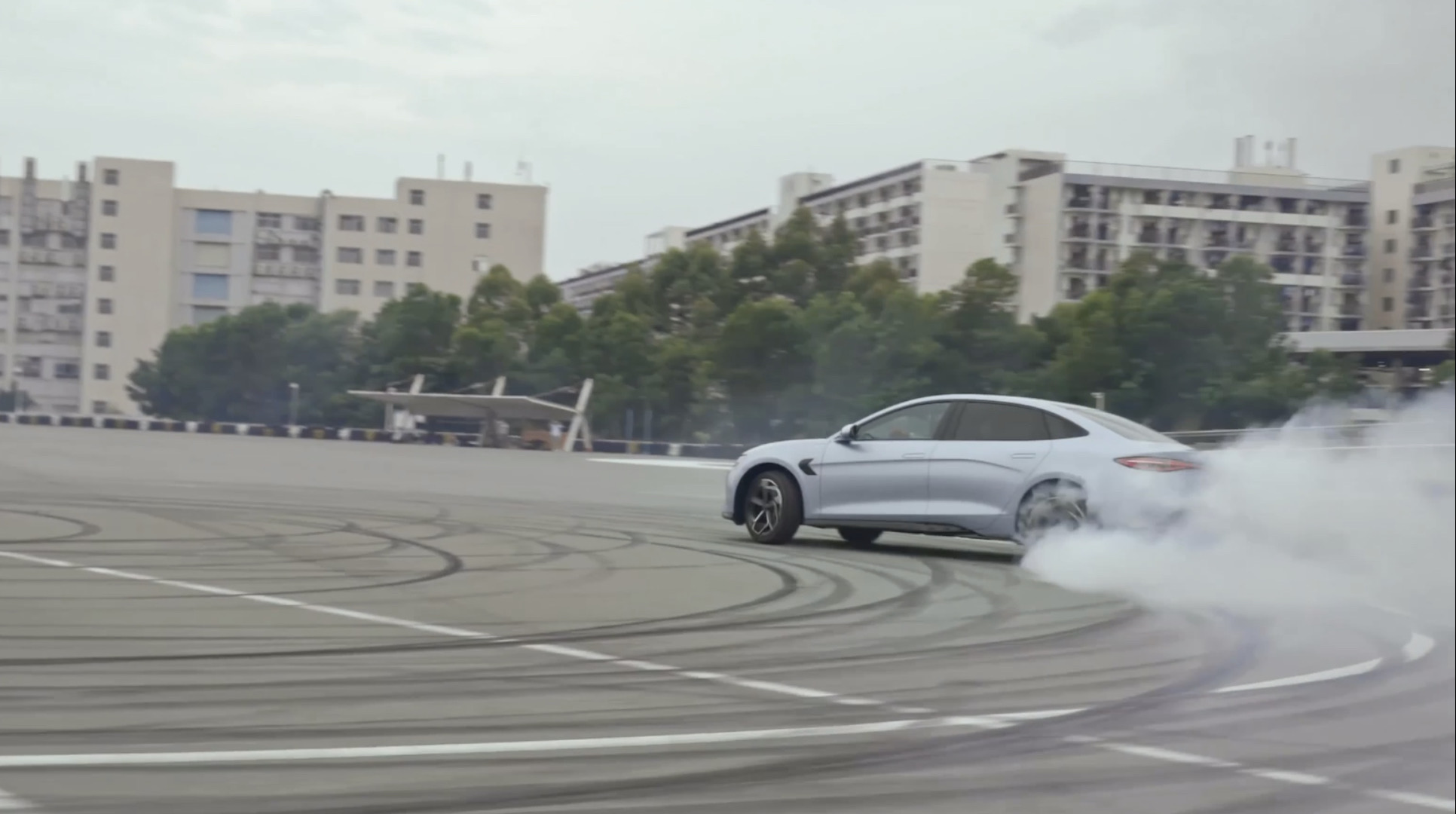
When used on a car, it can predict the grip condition of the vehicle in advance and allocate torque to prevent tire slip when the vehicle is about to slip.
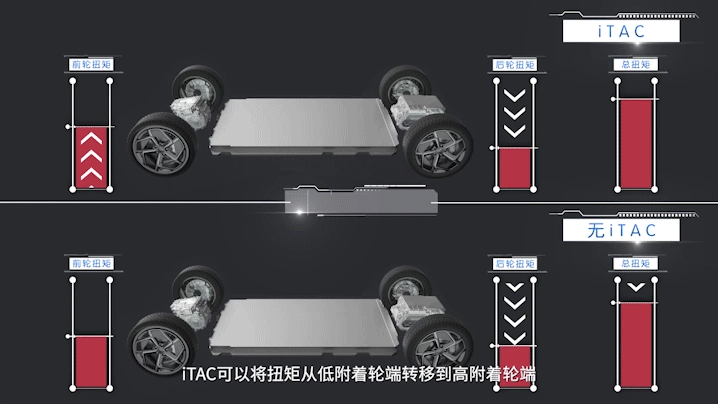
According to BYD’s official introduction, iTAC can make the vehicle start 0.7 seconds faster in snowy conditions. This also means that with the help of this system, the Sea Lion’s handling, off-road capability, and safety will be guaranteed, making it easier to handle this guy whose acceleration from 0 to 100 km/h is only 3.8 seconds.
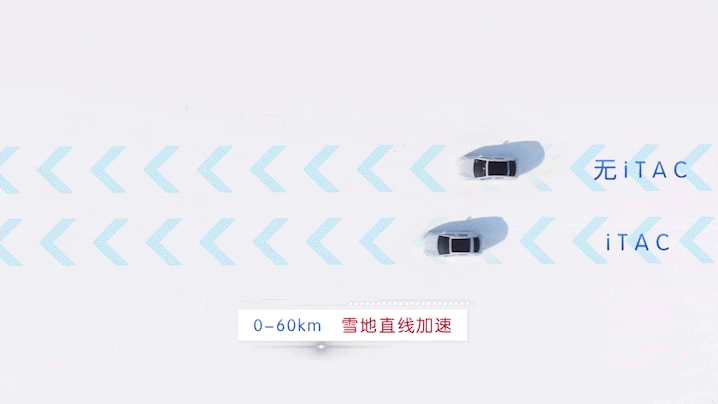
In comparison, the Han EV with a 0-100 km/h acceleration of 3.9 seconds is weaker in sports handling performance due to its different positioning, which is not surprising.
In addition to the top version, the Sea Lion also offers three pure rear-wheel drive versions. The power of the long-endurance version is slightly higher, at 230 kW and 360 N·m, and its acceleration is much faster than that of the Han EV long-endurance version. As for the two standard endurance versions, their 7.5-second acceleration is not weak and already matches the BMW 325i in the same class. It is completely sufficient for daily driving.
 If you are looking for more power and better handling, the iTAC four-wheel drive performance version of the Sea Lion is likely the best choice. If you simply want a car that is powerful enough and easy to drive, the Sea Lion might be a more appealing option than the Han EV.
If you are looking for more power and better handling, the iTAC four-wheel drive performance version of the Sea Lion is likely the best choice. If you simply want a car that is powerful enough and easy to drive, the Sea Lion might be a more appealing option than the Han EV.
No significant difference in range performance
While speed and drivability are important factors, range is definitely a key consideration for most people when buying an electric vehicle.
The BYD Sea Lion comes in two battery versions and three ranges: the standard range is 550 km, the long-range is 700 km, and the performance version is 650km. The two standard-range models can be seen as alternatives to the 20 standard-range Han EV models, with a similar price but an additional 50 km of range.
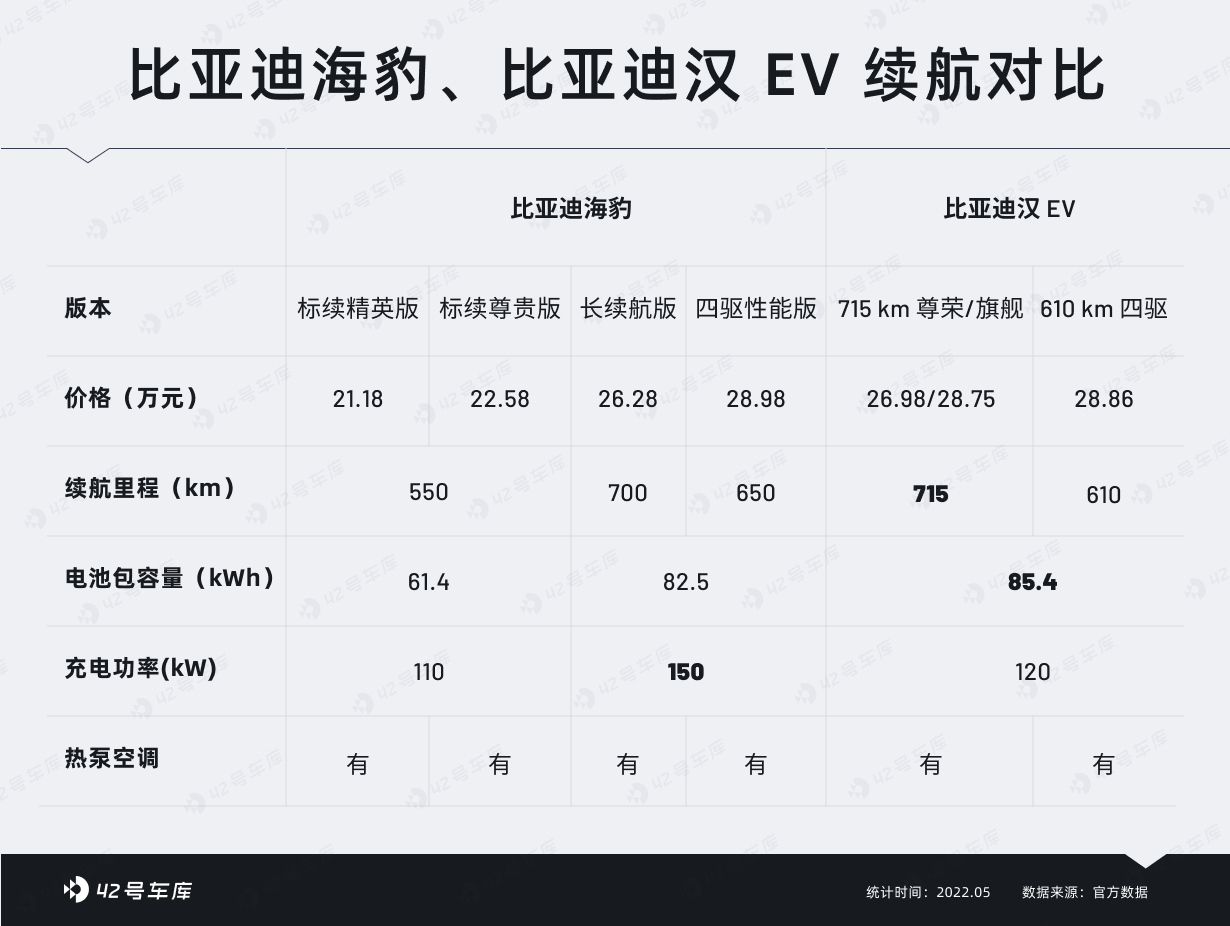
The long-range and four-wheel drive performance versions of the Sea Lion have similar ranges and prices to the three configurations of the 22 Han EV. The differences are due to the whole vehicle weight, air resistance coefficient, and various aspects of the motor, but these parameter differences are not significant.
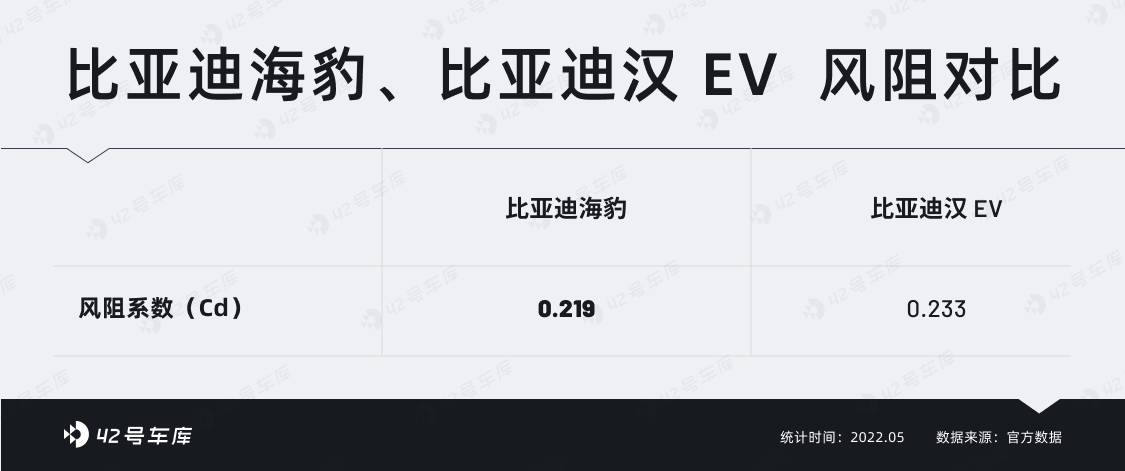
The charging power of the Sea Lion is worth mentioning. The two Sea Lions with 82.5 kWh of battery have a maximum charging power of 150 kW, and the charging technology with boost technology can raise the voltage to 600 V under the same current, undoubtedly significantly increasing the power.
Of course, the actual situation depends on how much power your direct current station can provide. In general, 110 kW and 120 kW are already sufficient, and the Sea Lion with the small battery (110 kW) should not have a significant difference in actual charging time.
Need to speed up the pace of assisted driving features.Currently, assisted driving is not BYD’s strong suit, and at this press conference, no detailed information was revealed about the more advanced assisted driving features of the Dolphin. Based on the current pace of development, early models have a chance of using the assisted driving system from the Han EV, while later models will be equipped with two LiDARs on the front bumper, similar to the layout of the XPeng P5, but the specific plan has not been announced yet.
It should be noted that all models of the Dolphin are equipped with only six ultrasonic radars (two on the front and four on the rear), which is why the automatic parking function does not appear on the configuration table. The number of millimeter-wave radars has also been reduced, and there is currently no information on surrounding sensing. Based on the configuration table, the Dolphin does not provide higher-level assisted driving configurations such as high-speed assistance and lane-change instructions. We can hope for further performance improvements in the Dolphin’s assisted driving capabilities in the future.
In the BYD Han EV 22 model, some functions of the DiPilot intelligent assisted driving system, such as the high-speed driving assistance system (HWA), emergency lane keeping assistance (ELKA), and forward traffic crossing warning system (FCTA), can only be used after OTA upgrades in the third quarter.
Compared to similar competitors, the XPeng P7/P5’s NGP is already at a very intelligent level, and Tesla’s assisted driving also provides a good user experience in China. Looking ahead, the NETA S will also be equipped with Huawei’s MDC 610 and multiple LiDAR solutions. Next, BYD also needs to accelerate its pace in assisted driving.
Final Thoughts
After this round of comprehensive comparisons, it is not difficult to see that even if the BYD Dolphin and Han EV overlap in terms of price range, range, and wheelbase, they are still two products with vastly different personalities.
If you are struggling between these two models, take a moment to think about what your needs are. Here are my purchasing recommendations for these two vehicles.For anyone who needs more space on a daily basis and wants to consider users who use their cars for business purposes, the Han Lion EV is the best choice. Whether it’s interior color matching or configuration, we believe you have a general answer in mind just by looking at the interior panel. If your goal in choosing a car is more focused on driving and handling, while still need to consider home use on a daily basis, the Sea Lion may better meet your needs.
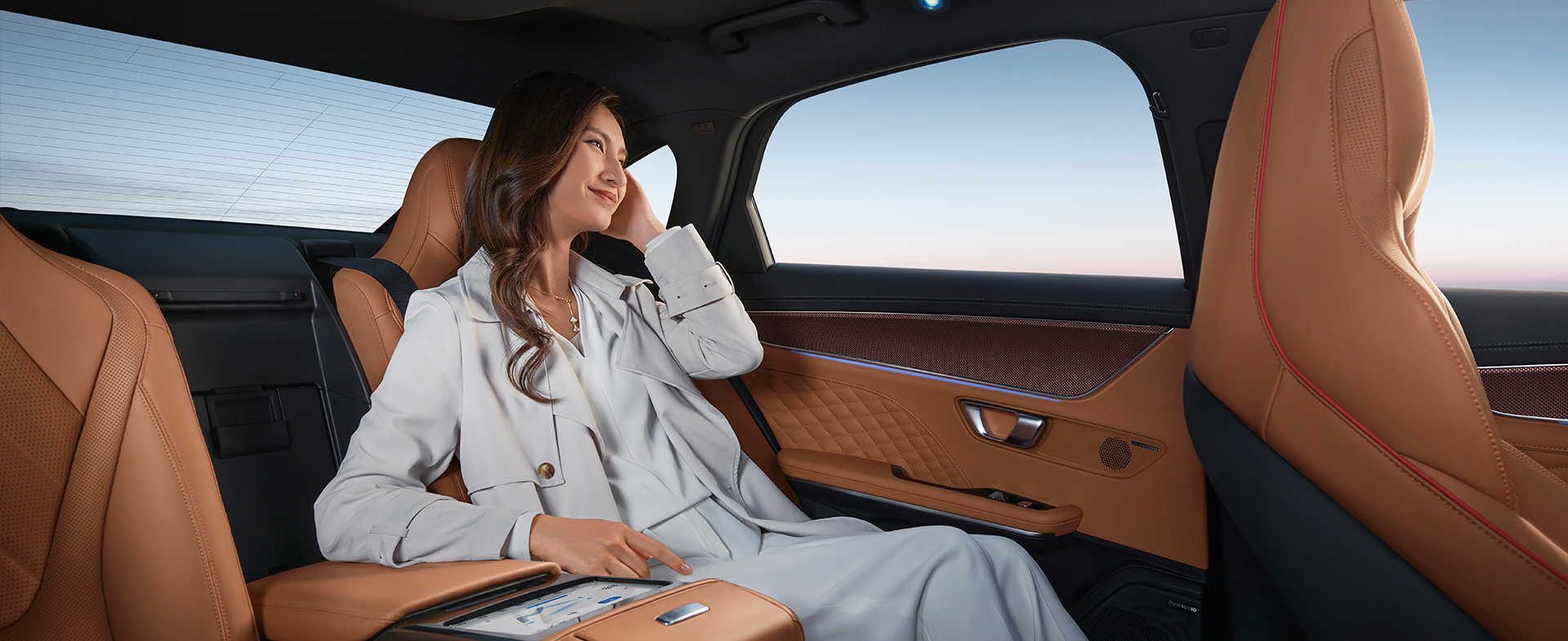
Among the four models of the Sea Lion, the top-equipped four-wheel drive performance edition is a bit more playful. If you don’t have a strong demand for power, there is no need to go for the highest configuration. The power of the other three models is enough to meet all daily needs.
The entry-level standard endurance Elite model is a car model that lowers the threshold. The middle two models are the ones that really drive the sales of the BYD Sea Lion. But the price difference between the middle two models is particularly large, reaching 37,000 yuan, which is due to a difference of 21 degrees of battery capacity and a small part of the difference in configuration. If you are not so sensitive to endurance and mostly use the car in the city, the standard endurance Enjoyment model, priced at 225,800 yuan, will be the most cost-effective choice. This configuration already has comfort features such as front ventilation and heating, Danaher, and ambient lights, and comes standard with assisted driving, which can meet daily needs very well.
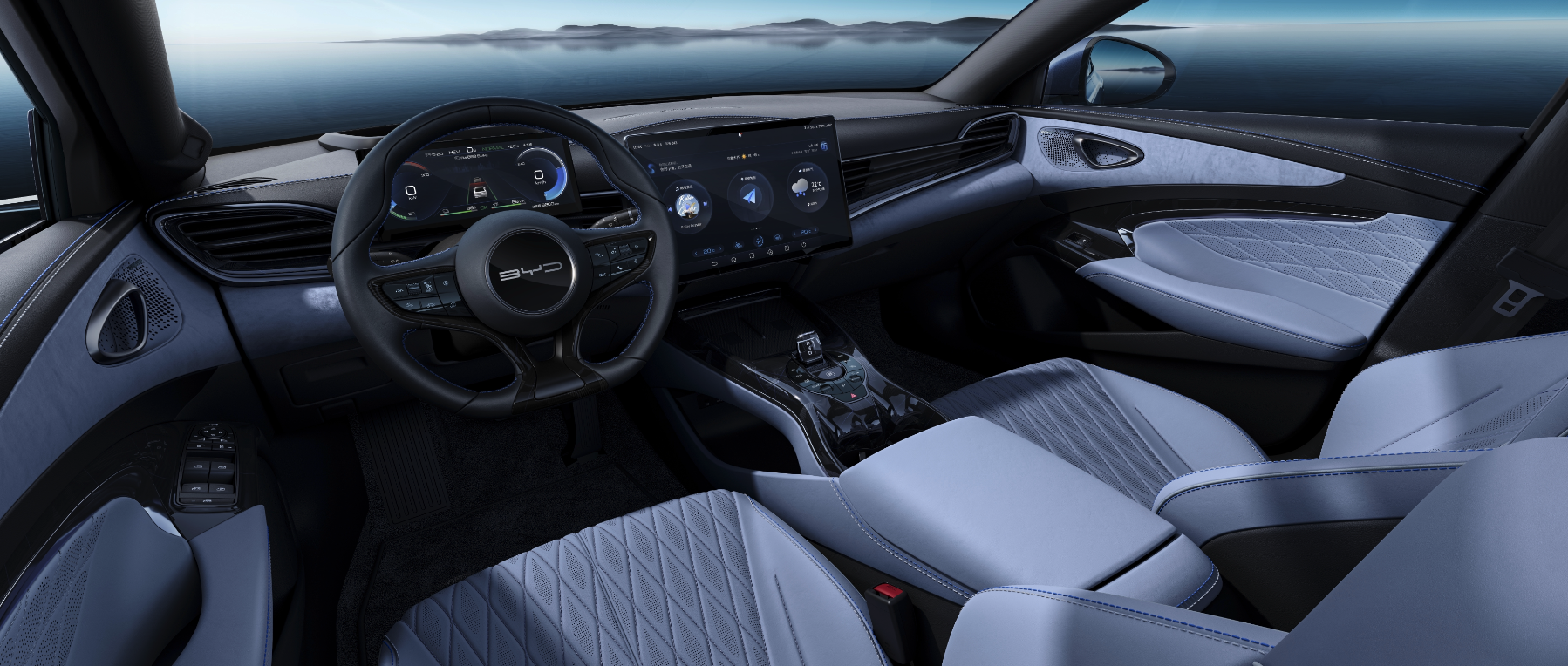
According to industry insiders’ analysis, the standard endurance Enjoyment model priced at 225,800 yuan accounts for 80% of pre-sales orders, and everyone is more rational in choosing configurations and more concerned about practicality. Speaking of which, the price of the Sea Lion is currently only a pre-sale price. As usual, the official price after listing still has room for reduction, so let’s wait and see.
For BYD, the emergence of the Sea Lion further helps BYD consolidate its sales. The cumulative sales of the BYD Han since its launch have exceeded 190,000 units. The Sea Lion will take over the relay of sports properties from the Han EV, and both cars are sub-divided into sports and business properties while meeting home use requirements, plus the BYD Han DM-i + DM-p, making users’ choice can’t avoid BYD. BYD’s dual-car strategy has officially started, and it remains to be seen how other companies will fight back.
This article is a translation by ChatGPT of a Chinese report from 42HOW. If you have any questions about it, please email bd@42how.com.
